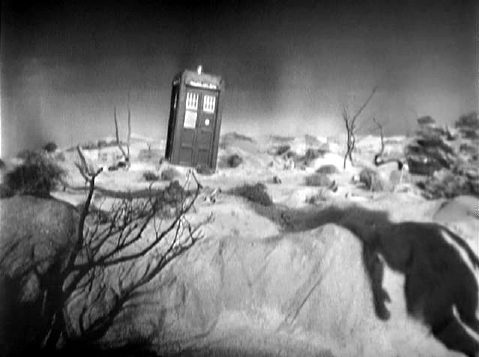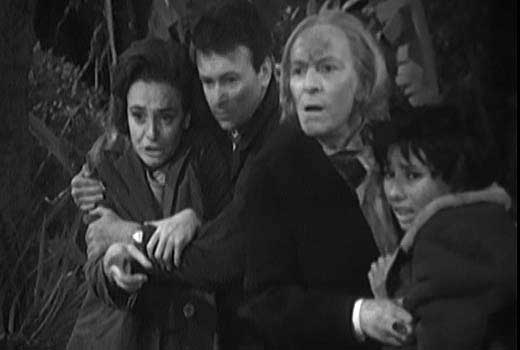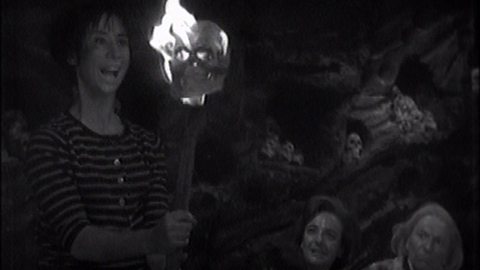As the song goes, the very beginning is a very good place to start.
As I pointed out in the introductory post, this blog isn’t about reviewing the episodes. Just take it as read that I enjoy all of Doctor Who (granted, I enjoy some parts significantly more than others). Instead, this blog’s focus is on the lessons I’ve learned from a lifetime of watching the series – and there are a certainly a number of life lessons that can be drawn from the first four episodes. These include valuable lessons about not rushing to judgement, about listening to your instincts, and teamwork and about hope and fear. But while these are all very useful, the most important lesson, as we’ll see, is none of these.
It has been pointed out many times that the first few minutes of the first episode are truly masterful. The unusual but now familiar theme continues to play out beyond the opening credits out as a policeman walks past the gates of the junkyard at 76 Totter’s Lane on a dark and foggy night. And as the junk yard’s gates open and the camera pans through, already there are questions:
– Who exactly opens the gate and why doesn’t the policeman notice?
– What exactly is that flashing light behind the police box?
– Is that a Weeping Angel next to the TARDIS? (And, yes, I know that they don’t appear in the series until the 21st century, but still…)
– What exactly is that sound?
It’s all quite unsettling and, even after all these years, vaguely scary. But before any of these questions can be answered, we’re at Coal Hill School, where all the students appear quite well-off and rather fashionably dressed (apparently the neighbourhood experiences a sudden decline and a school uniform policy is instituted between now and Remembrance of the Daleks). We’re introduced to teachers Ian Chesterton and Barbara Wright and student Susan Foreman – and a few things are instantly clear:
– Ian is either a “close-talker” or carries a torch for Barbara. Or probably a bit of both.
– Barbara is the kind of dedicated teacher that parents dread. As much as I would certainly appreciate her attention to my child’s progress, showing up at unannounced at my house and parceling out blame when my child’s homework hadn’t been quite up to scratch would be just about guaranteed to result in a response other than the one she would have been looking for.
– That said, Susan acts as if she’s on drugs, so perhaps I should go easy on Barbara.
Despite being a science teacher (and maybe because he is), Ian seems prone to ignoring the simplest explanations. Just a couple of examples:
– “I suppose she couldn’t be a foreigner.” (Because she’s white and has an English accent?)
– “We have a 15-year-old girl who is good at some things, bad at others and inexplicable at the rest.” (Sorry, Ian, but that sounds like a typical 15-year-old to me!)
To give him his due, the simplest explanations really don’t apply in this case. It’s almost as if instinctively knew he was about to kick off a 50+ year adventure in time and space. Of course, it turns out that Ian is right – sometimes the best explanations are not actually the simplest ones!
So off to the junk yard they go. In the days before anti-stalking legislation, they follow Susan to Totter’s Lane, indulge in a little junkyard breaking and entering, and stumble around in the dark until the Doctor appears.
One of the first things that strikes you when you see this story for the first time is that William Hartnell is downright creepy as the Doctor. Far from being the heroic figure he would later become, this Doctor is more than slightly cantankerous, highly evasive, and clearly rather put out by these interlopers – basically, he’s me on an off day.
But much more than that, to both Ian and Barbara, he’s an old man with a hidden agenda hiding a teenage girl in an apparently disused police box at the back of a deserted junk yard. Even in pre-Saville days, that would be enough to set off one or two alarm bells. And things really don’t improve when they find their way into the TARDIS (which Susan apparently named – personally, I think she’s taking credit for someone else’s work), where they find themselves kidnapped and dragged off to the stone age by a man that could well be invited to help police with their enquiries at some future date.
Once the TARDIS has landed in the stone age, and Ian and Barbara have begun to come to terms with the idea of moving in time and space, it’s the Doctor’s turn to demonstrate a particularly useful lesson (and one that I really should pay more attention to) – that smoking is bad for you. After all, if he hadn’t stopped to light his pipe, he wouldn’t have been knocked on the head by a randomly passing caveman, and wouldn’t have needed rescuing by Ian, Barbara, and Susan (a rescue, incidentally, that Susan throws herself into with a disturbing amount of relish). And, what’s more, we wouldn’t have been subjected to interminable debates about fire, furs and cold by the tribe’s prospective leaders (leading to another lesson that’s as true now as it obviously was in stone age times – politicians really are boring).
The third episode opens with a number of potential life lessons as the Doctor, Ian, Barbara and Susan struggle to escape from the Cave of Skulls. Among them are:
– Ian: Any hope is better than none.
– The Doctor: Fear makes companions of us all.
– Me: It’s worth looking around before you begin trying to move the big rocks – you may well just see that the bundle of sticks in the corner is simply covering a far easier escape route. Why make things more difficult for yourself than they already are?
Also, Barbara later shows us that if you’re going to talk to foreigners, it’s best talk slowly and enunciate carefully using the simplest of grammar. Legions of EFL teachers around the world have carefully followed her example.
And so we reach the final part of the very first journey, whack results in some useful lessons all round:
– “Cal is not stronger than the whole tribe”: A teamwork lesson shared by Ian, which Za appears to promptly forget.
– There’s really no pleasing some people: After helping to heal Za, drive off Cal and restore Za to his rightful place as leader, Ian, Barbara, Susan and the Doctor are bundled off back to the Cave of Skulls.
– If you’re going to get trapped in the Paleolithic era, it’s a good idea to brush up on your fire-making skills: This is a lesson that potential Survivor contestants really should pay attention to, as it applies equally to modern-day island/jungle-based reality shows.
– Speak loudly and slowly to foreigners (again): The Doctor has obviously taken his cue from Barbara.
– Pay attention to the weird girl – she may just have a solution to your problem: And interestingly, it’s not Susan who solves the problem by sticking a burning torch inside the skull. It’s Ian that figures out what needs to be done – Susan apparently just has a thing about desecrating remains. Just as well they left Earth – it may not have been long until Social Services were knocking on the TARDIS door. And what great time travel companions they would have made.
– And, in the last few moments of the episode, don’t trust the weird girl to give you a reliable instrument reading.
So, there’s rather a lot to be learnt from this very first adventure in time and space. But, as I noted many paragraphs back, the most important lesson of all is this…
Basically, your mother was right – don’t trust strange men who hang around in deserted junk yards. Unless, of course, he’s the Doctor. And even then it pays to keep your wits about you.



